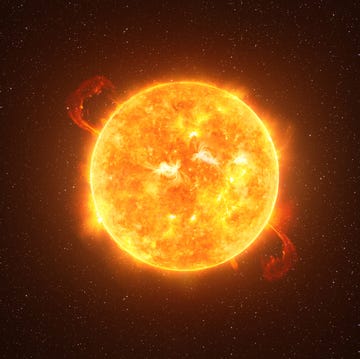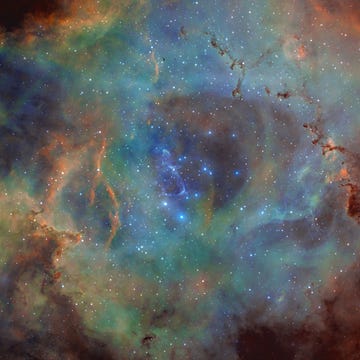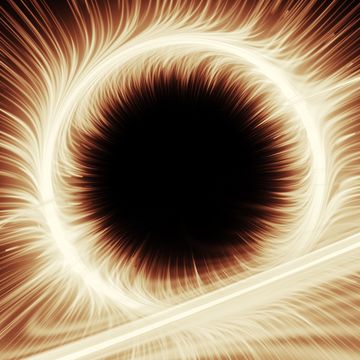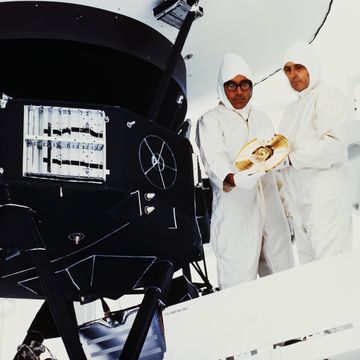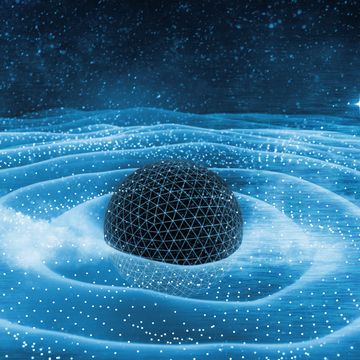Name: Artificial world
Selected Science Fiction Portrayals: The two Death Stars from the Star Wars films and related media; Shellworlds in Iain M. Banks 2008 novel Matter; custom-made luxury worlds in Douglas Adams' The Hitchhiker's Guide to the Galaxy series.
If humans are going to live in an off-world habitat, then it must have the things we've evolved to depend on here on Earth: the right temperature range, breathable air, specific gravity, day-night cycles, and plenty more. But rather than gussying up a spinning, tin can space station, wouldn't it make more sense to re-create our planet by building an artificial world?
The term "artificial world" can be interpreted in two ways. The literal interpretation is a planetary replica—a massive chunk of rock fabricated to be essentially indistinguishable from real planets and moons crafted by nature. The other way is to imagine something that merely looks like a world—say, a spherical space station like the Death Star in Star Wars. This second kind of object would not be inherently planet- or moon-like, except in its shape. But through clever engineering, perhaps function might follow form more readily than you might think.
With either approach, engineers would have a hell of a job on their hands. "I don't want to be a wet blanket, but at least for things we know about today, [when it comes to building an artificial planet,] you run into problems," says Adam Steltzner, an engineering fellow at NASA's Jet Propulsion Laboratory in Pasadena, Calif.
RELATED: The Shkadov Thruster, or: How to Move an Entire Solar System
"That's No Moon"
Let's start with the second option—the Death Star. It seems more promising than building a true replica planet if only because of size. According to Star Wars lore, the first Death Star in Star Wars Episode IV: A New Hope, had a diameter of 74 miles. That's big, but not when compared to Earth's nearly 8,000-mile diameter. Assuming the approximate density of an aircraft carrier, as the economics blog Centives has done, the mass of a Death Star made mostly from steel works out to about a quadrillion tons—only about one one-millionth of the Earth's mass. Easy!
But acquiring even that amount of material through today's mining technology would be an absurd quest. Given a 2012 world steel production rate of 1.43 billion tons annually, Centives figured it would take more than 800,000 years to acquire all the necessary steel. The price tag? A staggering $852 quadrillion, or about 13,000 times the entire world's combined gross domestic product. Worse yet: launch costs. Rocketing materials from Earth's surface into space runs on the order of thousands of dollars per pound currently.
The only plausible way to procure materials cheaply is to get them from low-gravity environments, like the Moon and asteroids. "It would be smart … to mine space, rather than try to rocket up a steel I-beam," Steltzner says.
Orbital Construction Site
Next comes fashioning a quadrillion tons of steel into a sphere with a complex internal structure. It would be extremely difficult, but not impossible. Robots would have to (quickly) handle the majority of the work if it were to be completed in a reasonable amount of time; otherwise you're talking about employing armies of space-suited construction workers for millennia.
RELATED: 10 of the Maddest Scientists Who Ever Lived.
For reference: The world's tallest building, the Burj Khalifa, has a mass of nearly a million tons and took three years to erect, with upwards of 10,000 workers on-site. However, this analogy is not quite apt (though nothing humanity has ever done really compares to building a Death Star). While the artificial world would requires an ridiculous amount of metal, moving those giant hunks around in space could be much easier (with the right machines, anyway) than working in a broiling desert beset by gravity
Also consider the internal structure. The Death Star includes more than 21,000 floors stacked like stories in an office building. This configuration would never be feasible—unless we invented some kind of artificial gravity generators to keep people, furniture, and droids rooted to the floor.
Gravity, the Good and the Bad
Earth-like gravity would be absolutely essential for long-term living. "Our human bodies get all messed up when we don't have one Earth 'g'," Steltzner says. Astronauts aboard the International Space Station have to deal with bone mass loss and low blood pressure, among other issues, from extended stays in microgravity.
Alas, artificial gravity generators defy known physics. Instead, the artificial lunar megastructure would need to rotate to produce gravity, via centrifugal force, outwardly along its equator. Instead of stacked floors, habitat levels in an artificial moon could resemble layers in an onion. In an inverse of terrestrial reckoning, occupants' heads, instead of their feet, would face "down" toward the megastructure's center. Gravity, too, would be backwards. "At the center of the structure there is no gravity, and you get more as the floors go out," noted Steltzner.
RELATED: Your Questions About the Gravitational Waves Controversy, Answered.
Getting rotation itself would be simple. Angled rockets could start the whole thing spinning and maintain it at the rate required for Earth-like gravity. The rockets would not need to continuously fire, either. "Because the structure's spinning out in space, there's nothing there to slow it down," Steltzner says.
Yet rotating the artificial moon creates fresh problems. The sections of the structure subjected to one Earth gravity or more would have to possess a high enough strength-to-weight ratio to keep from ripping apart. Steel might not cut it for a 74-mile diameter structure, Steltzner says. A better bet: zylon, a synthetic fiber with the best strength-to-weight ratio known, which is seven times stronger than steel and about twice Kevlar's toughness. Zylon is organic, meaning it contains carbon. So carbon-rich carbonaceous asteroids would be good mining targets for this approach.
Earth, Redux?
For all its engineering challenges, building our Death Star-inspired space habitat would be far easier than constructing a replica Earth. But it could never match a second Earth on one thing: stability.
"All of these structures or ideas for colonies suffer from one sort of inherent, substantial flaw that is summed up in a term: instability," Steltzner says. "Active maintenance is needed for the environment to be maintained, like the exact right orbital parameters. They're much, much less stable than our planet."
Ergo, why not just make another one?
Mark Hempsell, an aerospace engineer who worked for Reaction Engines Limited and has recently started a private consultancy, took a crack at artificial planets in a 2005 study in the Journal of the British Interplanetary Society, of which he is a former editor. He wanted to compare the feasibility of terraforming a planet—that is, geo-engineering it to be like Earth, a painstaking project that would probably take centuries on a world like Mars—versus building one from scratch.
Churning Out a Custom Planet
Hempsell points out that to replicate Earthly conditions, you don't have to mimic Earth to a "t." For example, mass and distance determine gravitational attraction. So, to get Earthly surface gravity, engineers could cheat by packing just a tenth of Earth's mass—say, 700 quintillion tons—into a sphere the size of the Moon (diameter: 2,159 miles). That's still an awful lot of rock, but Hempsell explored how engineers might acquire that material and mimic nature's planet-growing, bottom-up process.
Ordinarily, within a disk of leftover material around a newly formed star, molecules aggregate, bit by bit, into larger and larger chunks, and over millions of years develop into a world. To speed things up, Hempsell suggested deploying a futuristic, gigantic super-fusion facility near the Sun—a megastructure to make a megastructure. Using magnetic fields, the facility would harvest abundant hydrogen from the Sun's surface. Onboard fusion reactors would produce desirable heavy elements to comprise the planned faux-Earth.
To squish a Mars-sized mass into a Moon-sized volume, engineers would want the densest elements on the Periodic Table, including osmium, iridium and platinum. Admittedly, these elements can only be made in the thermonuclear explosions of supernovae, and not through conceivable, garden-variety fusion machines. "We're talking about some spectacular fusion technology," Hempsell says. But at least the laws of known physics could still be obeyed.
The facility would launch ingots of these materials out to where the artificial planet would be built up, piecemeal, as ingots collide and bind. All that ingot smashing would generate significant heat throughout the budding world, on par with the 10,000-degree-Fahrenheit surface of the Sun. After a century of cooling to about 3,000 degrees Fahrenheit, ingots of crustal elements, such as silicon, could be layered on top. Another period of cooling would then need to take place, lasting about 10,000 years, until the surface would be cool enough to dump water for oceans and establishment of plant life.
In summary… Hempsell's paper demonstrated that world-making is best left to nature.
"Unless something radically different happens," said Hempsell, "when looking at terraforming things, the paper came to the conclusion that building your own planet is not going to be any quicker."







